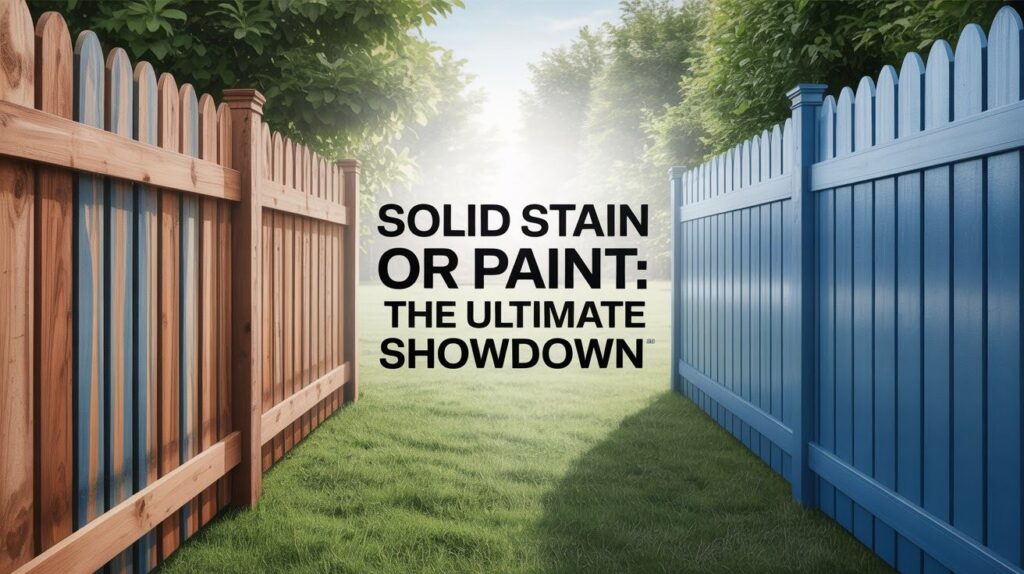After fifteen years of coating exterior surfaces, I’ve watched homeowners wrestle with the same fundamental question: solid stain or paint?
Both products promise protection and beauty, yet they perform dramatically differently in real-world conditions.
This choice isn’t just about color preference-it impacts your project’s longevity, maintenance schedule, and overall satisfaction for years to come.
I’ve seen gorgeous paint jobs fail within two seasons due to poor product selection, while properly applied solid stains continue looking fresh after a decade.
Understanding each coating’s strengths and limitations helps you make the right decision for your specific situation. Let me share what I’ve learned from countless projects about when to choose solid stain versus paint for optimal results.
Side-by-Side Comparison
| Feature | Solid Stain | Paint |
| Appearance | Enhances natural texture of surface | Completely covers surface texture |
| Durability | Penetrates surface for long-lasting color | Creates protective film on surface |
| Maintenance | Easier to touch up | Requires full repaint for touch-ups |
| Moisture Resistance | Allows surface to breathe | Seals surface completely |
| Application Time | Usually requires fewer coats | Often requires primer + multiple coats |
| Fading Over Time | Fades gradually and evenly | May peel, chip, or blister |
| Best For | Decks, fences, exterior wood | Siding, trim, interior/exterior walls |
| Cost | Slightly lower on average | Slightly higher on average |
Understanding the Basics
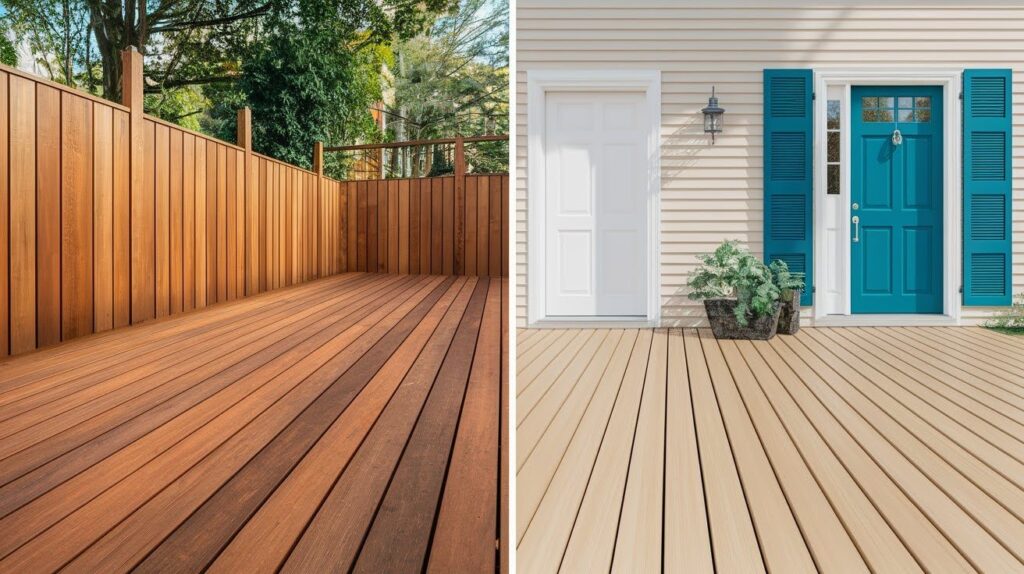
Learn the fundamental differences between solid stain and paint to make informed coating decisions for your project.
What Is Solid Stain?
Solid stain is a penetrating coating that soaks into wood fibers while providing opaque color coverage similar to paint.
Unlike surface coatings, solid stain bonds with the wood’s cellular structure, creating protection from within. This penetration allows the wood’s natural texture to remain visible and tactile while hiding grain patterns and previous stain colors.
I typically recommend solid stain for horizontal surfaces like decks, where foot traffic and weather exposure are constant concerns.
It works exceptionally well on fences, cedar siding, and outdoor furniture where maintaining the wood’s natural feel is important. The penetrating nature means it won’t peel or chip like surface coatings, making it ideal for areas that experience frequent expansion and contraction cycles.
What Is Paint?
Paint creates a protective film layer on top of surfaces, forming a barrier between the substrate and environmental elements.
This film-building quality provides superior moisture protection and allows for easy cleaning, making paint the preferred choice for high-maintenance areas.
Paint excels on properly prepared smooth surfaces where a uniform, finished appearance is desired.
I use it extensively on trim work, front doors, shutters, and any area where frequent cleaning is necessary.
Interior applications benefit from paint’s ability to hide surface imperfections and provide consistent color coverage across different materials like drywall, wood, and metal substrates.
Appearance and Finish
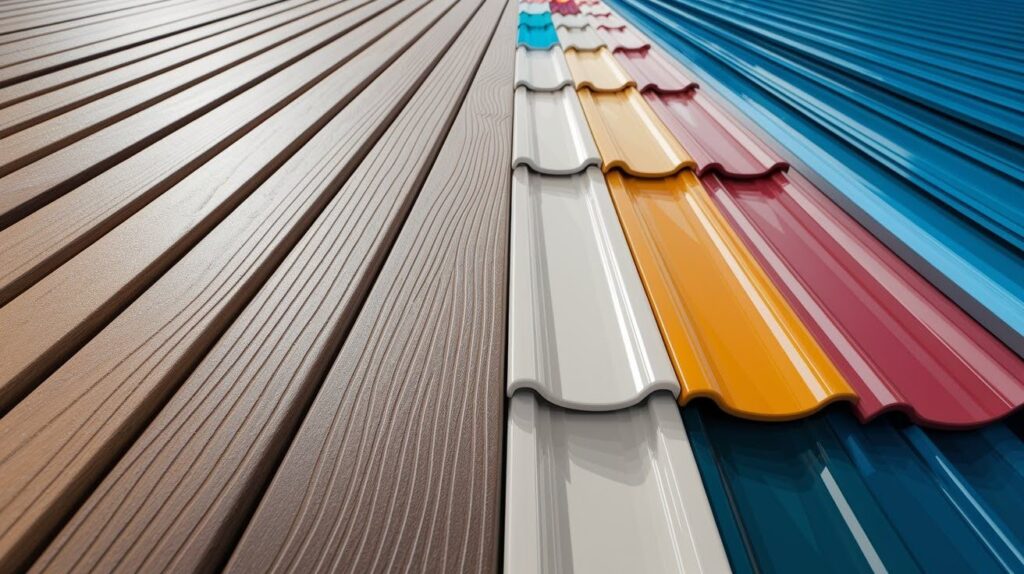
Compare visual differences between solid stain and paint, including texture preservation, color options, and finish effects on surfaces.
Look and Texture
Solid stain allows wood grain patterns to show through while providing opaque color coverage, creating a natural appearance that maintains the wood’s original character.
The penetrating formula preserves surface texture, so you can still feel the wood’s ridges and grooves beneath the coating.
Paint completely conceals wood grain and creates a smooth, uniform surface that hides all underlying texture and imperfections.
Both products offer various sheen levels-matte finishes provide a flat appearance with minimal reflection, while semi-gloss and gloss options add shine and make surfaces easier to clean.
From my experience, higher gloss levels show surface flaws more readily but offer better moisture resistance for high-exposure areas.
Color Range and Customization
Paint typically offers the widest color selection, with thousands of custom tinting options available at most retailers. You can match virtually any existing color or create custom shades to complement specific design schemes.
Solid stains traditionally came in limited earth tones and wood-inspired colors, but modern formulations now include broader palettes with grays, blues, and other contemporary options.
However, stain colors often appear different on various wood species due to the wood’s natural undertones affecting the final appearance.
I always recommend testing both products on inconspicuous areas to ensure the final color meets your expectations before committing to full application.
Durability and Protection
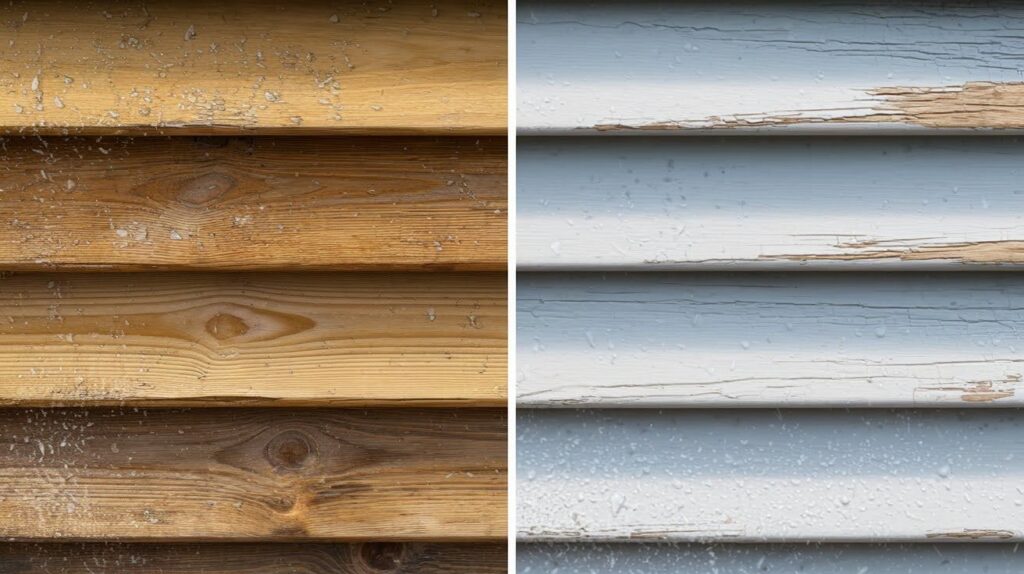
Weather Resistance
- Solid Stain Performance – Penetrates wood fibers to create internal weather resistance while allowing moisture to escape, preventing trapped water that causes rot. UV protection depends on product quality and pigment concentration.
- Paint’s Protective Barrier – Forms surface film that excels at blocking moisture penetration and provides superior UV protection through dense pigmentation. Can trap moisture if water enters through cracks or worn areas.
Longevity
- Solid Stain Lifespan – Requires reapplication every 3-5 years on horizontal surfaces like decks, 6-8 years on vertical applications. Wears gradually without peeling, making touch-ups easier.
- Paint Duration – Lasts 7-10 years on properly prepared surfaces before complete renewal. Premium products with higher solids content often last twice as long as budget alternatives.
- Performance Factors – Surface preparation quality, application conditions, exposure intensity, and maintenance frequency affect both coatings. Regular cleaning and prompt repairs significantly extend the effective lifespan of both products.
Application Process
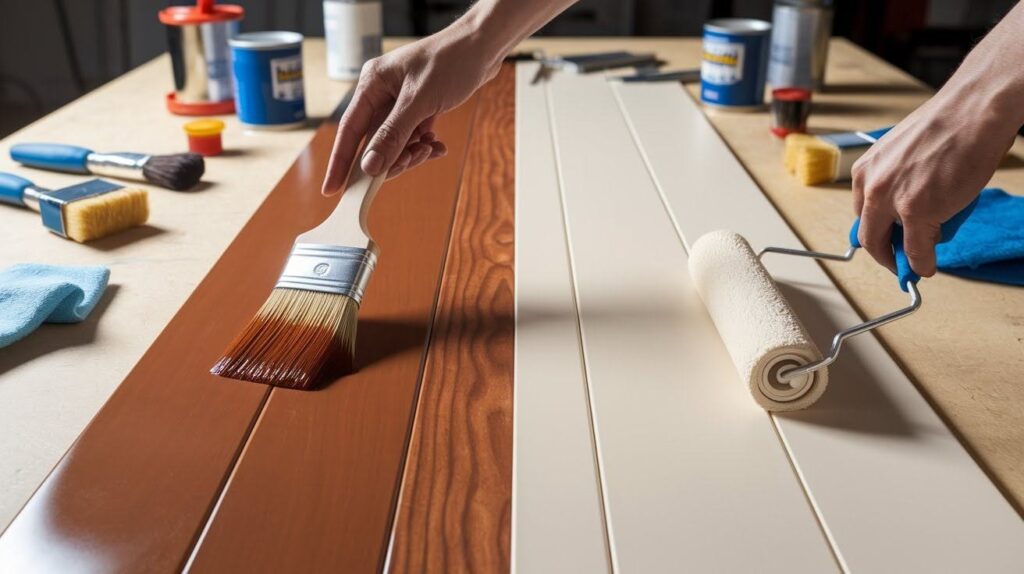
Comprehensive guide covering essential surface preparation steps and application techniques for achieving professional wood staining and painting results.
Surface Preparation
Proper preparation forms the foundation of any successful wood finishing project. Begin by thoroughly cleaning the surface to remove dirt, grease, and old finishes.
Sand the wood systematically, starting with coarser grits and progressing to finer ones for a smooth base.
Apply primer when working with raw wood or making dramatic color changes. For aged or damaged wood, extra attention is needed – fill holes and cracks, sand out imperfections, and consider using specialized primers designed for problem surfaces.
Ease of Application
Stains typically require brushes, rags, or foam applicators and penetrate quickly, demanding swift, even coverage.
Paint applications use brushes, rollers, or sprayers and offer more working time. Stain dries within hours but needs 24-48 hours to fully cure.
Paint requires longer drying periods between coats but provides more forgiving application windows for achieving professional results.
Expert Recommendations
Professional insights and proven techniques for achieving flawless wood finishing results while avoiding costly application errors.
Tips from Professional Painters and Contractors
- Invest in quality brushes and tools for superior finish quality
- Work in manageable sections to maintain wet edges and prevent lap marks
- Test chosen finish on hidden areas before full application
- Apply multiple thin coats instead of single thick applications
- Choose optimal weather conditions – avoid extreme temperatures and high humidity
- Maintain consistent application pressure and direction throughout the project
Common Mistakes to Avoid
- Rushing preparation stages leads to poor adhesion and uneven results
- Skipping primer when changing wood types or colors creates inconsistent coverage
- Over-brushing stain causes streaking and uneven penetration
- Applying coats too quickly without proper drying time results in peeling
- Using cheap brushes leaves visible streaks and bristle marks
- Inconsistent application techniques create unprofessional appearances
Conclusion
After years of working with both stains and paints on countless projects, I’ve learned that the choice ultimately depends on your specific goals and circumstances.
Stains offer natural beauty and cost-effectiveness but require more frequent maintenance and provide limited color options.
Paint delivers superior protection, endless color choices, and longer-lasting results, though at higher initial costs and with more complex preparation requirements.
My advice? Consider your budget, maintenance preferences, and desired aesthetic carefully. If you love wood’s natural character and don’t mind regular upkeep, stain is your friend.
For maximum durability and design flexibility, paint wins every time.
Remember, there’s no universally “right” choice – only what works best for your home, lifestyle, and personal vision. Trust your instincts and choose what makes you happy with your space.
Frequently Asked Questions
What’s the main difference between solid stain and paint?
Solid stain penetrates wood fibers while allowing some grain texture to show through, creating a more natural appearance. Paint forms a protective film on the surface, completely covering wood grain but offering superior durability and weather resistance.
Which option lasts longer on exterior surfaces?
Paint typically provides longer-lasting protection, often maintaining its appearance for 7-10 years with proper application. Solid stain usually requires reapplication every 3-5 years, depending on weather exposure and wood type.
Can I apply paint over existing solid stain?
Yes, but proper preparation is crucial for good adhesion and long-term performance. Clean the surface thoroughly, sand lightly, and apply a high-quality primer designed for stained surfaces before painting.
Which is more cost-effective in the long run?
While solid stain has lower upfront costs, paint often proves more economical over time due to its longevity. Consider both initial investment and maintenance frequency when calculating total ownership costs for your specific project.
How do I choose between solid stain and paint for my home?
Consider your maintenance preferences, desired appearance, and local climate conditions when making this decision. Choose solid stain for natural wood beauty with moderate upkeep, or select paint for maximum protection and design flexibility.

